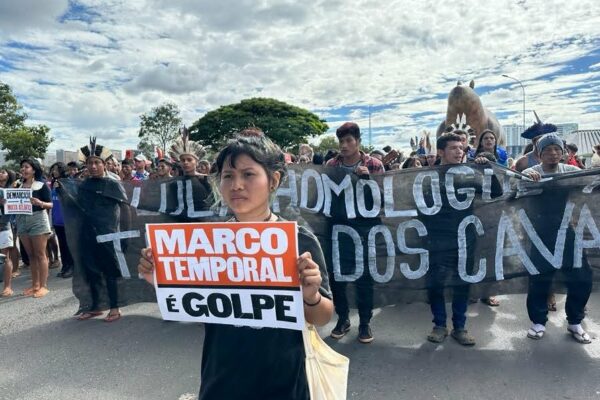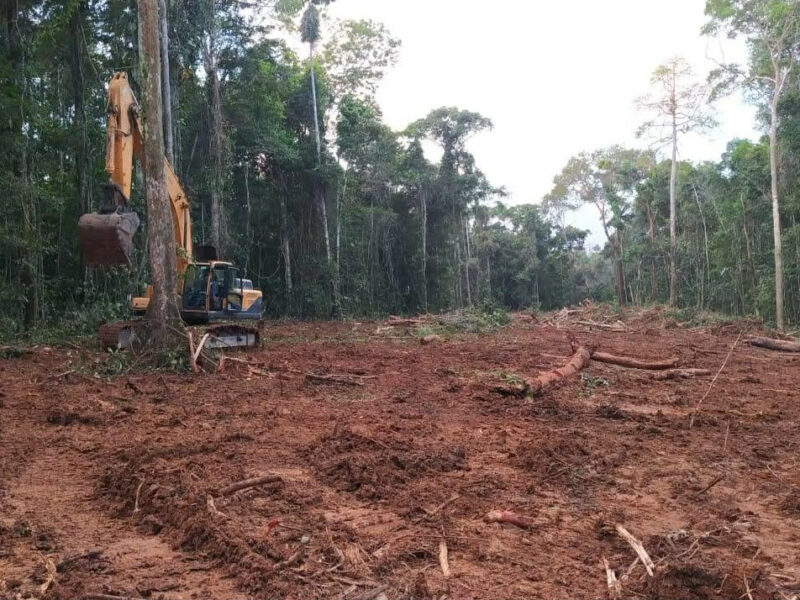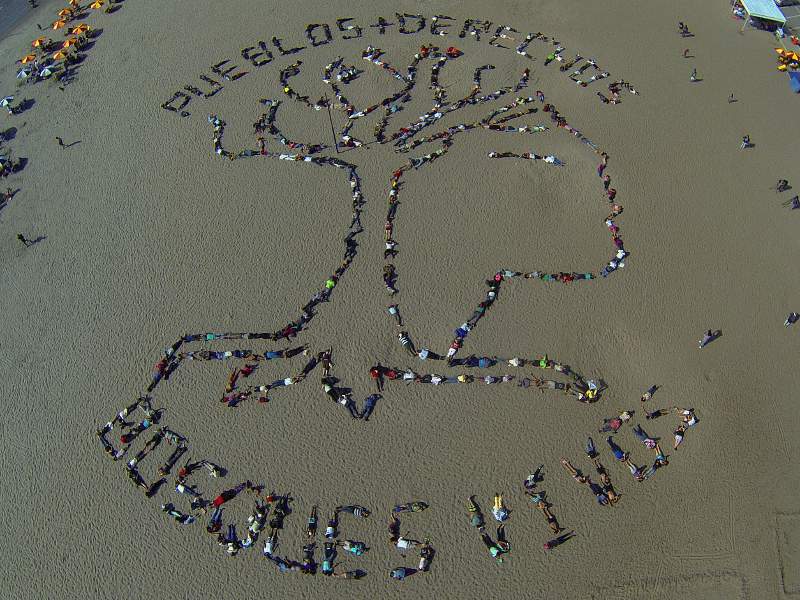
“If we want to defend our global climate, we must defend the Amazon.
If we want to defend the Amazon, we must support indigenous rights and territories.”
Earlier this month, the world’s eyes were on Lima as 196 nations debated what to do about climate change at the UN COP20 climate summit. While world leaders debated, negotiated, signed and didn’t sign agreements, Amazon Watch and our allies sounded the alarm on the critical importance of the Amazon rainforest and indigenous ancestral territories in maintaining climate stability.
“I think this COP20 is important because it’s the first COP ever in an Amazon country,” said Amazon Watch founder Atossa Soltani in an interview with Democracy Now! “The Amazon is incredibly important in the climate debate, both because deforestation is a huge source of emissions, but also because the rainforests of the Amazon actually are the rain machine for the planet. They create these flying rivers that basically provide fertile rain to the entire continent and the rest of the world. It’s like the heart of the planet, pumping moisture and vapor. So, when we lose the Amazon, we not only create emissions, but we lose the climate-stabilizing function of the forest.”
And in order to protect the Amazon, we must support indigenous land rights and keep fossil fuels in the ground.
Our work in Lima was a continuation of the momentum built in New York during the People’s Climate March and a step towards planning for comprehensive climate action in the coming year. In Lima, Amazon Watch highlight activities included:
- Supporting Amazonian women who are leading solutions on the frontlines of climate change including Patricia Gualinga and Nina Gualinga from the Kichwa community of Sarayaku;
- Exposing major threats from a wave of egregious extractive and infrastructure projects planned for the Amazon, including expanding the oil frontier in the western Amazon and mega-dams in the Brazilian Amazon; and
- Promoting solutions championed by indigenous peoples from seeking title to ancestral territories, to creating life plans, defending sacred lands, and heralding paradigm shifting concepts like Buen Vivir (“Plentiful Living”), Selva Viviente (“Living Forests”), and the Rights of Nature.
Amazon Watch was proud to partner with our allies in numerous events including a two-day International Tribunal on the Rights of Nature dedicated to indigenous Shuar leader Jose Tendetza, who was found dead a day before he was set to travel to Lima to participate in the event. He, like Edwin Chota, an Ashaninka leader from the Peruvian Amazon who was assassinated with three brothers by illegal loggers in September for defending the ancestral territory of the Ashaninka, is now a symbol of hope and resistance amidst threats and attacks by industry and infrastructure including mining, logging, agribusiness, oil and gas, roads and dam development in the Amazon. Read more in the “Murder in the Rainforest” article in Rolling Stone.
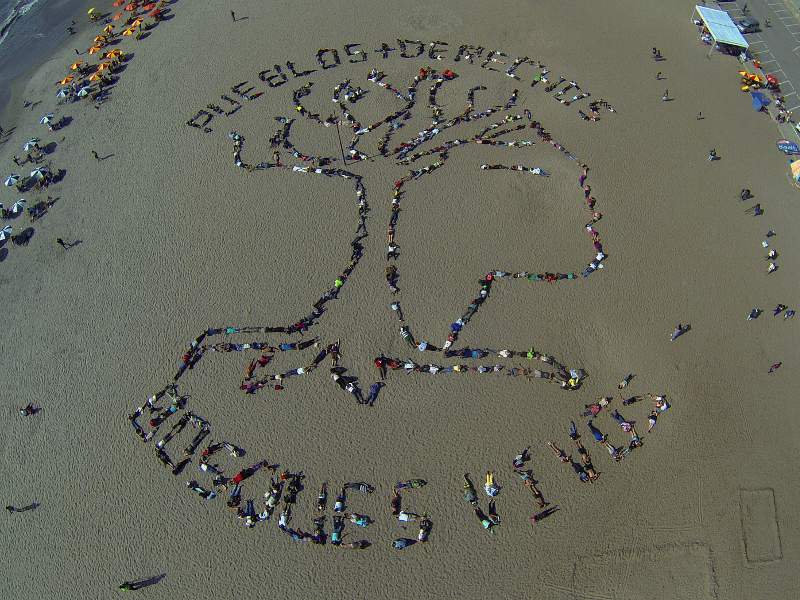
Peoples + Rights = Living Forests!
We coordinated a massive human banner with AIDESEP, COICA and Spectral Q on the beach in Lima to bring awareness to the urgent need for indigenous and territorial rights in the Peruvian Amazon and throughout the Amazon, where 100 million hectares await territorial recognition. The banner artistically displayed a tree with the face of Pachamama and the words “Pueblos + Derechos = Bosques Vivos” (Peoples + Rights = Living Forests).
“Together we created a beautiful image of what we want to see in the world. We want our rights and territories respected, here in Peru, across the Amazon and around the world,” said Juan Agustín Fernandez, leader of the Shipibo community of Cantagallo in Lima who helped create the banner.
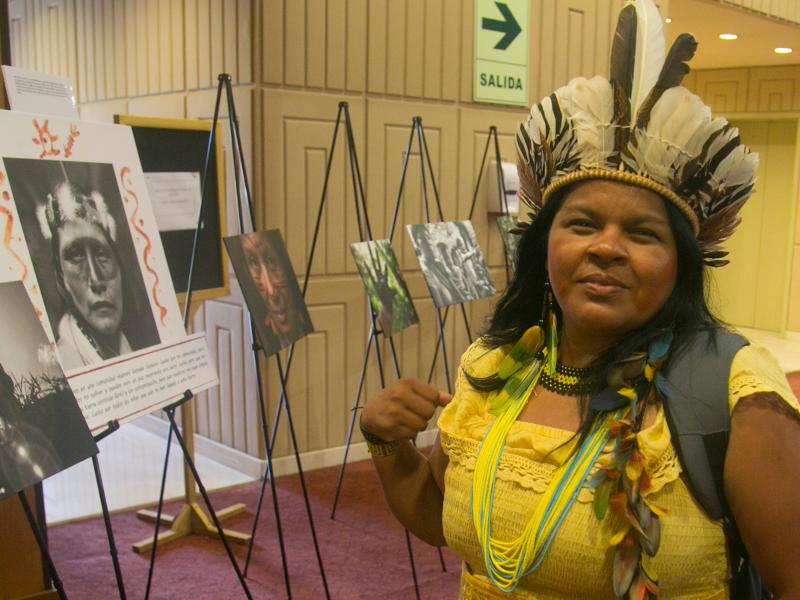
“I’m here to bring the voice of indigenous women, in particular of Brazil, those who couldn’t be here with us…so that we could unite our voices, because the reality is that in many of the organizations, there is not a space for women and indigenous women to participate. And so, many times they feel suffocated for the words that they cannot say.”Sonia Guajajara

“The destruction of nature is the destruction of our own energy and of our own existence here on Earth. And the destruction of our spaces is the destruction of indigenous populations. And even though you might not believe this – this is your destruction as well.”Patricia Gualinga
We Can!
We joined our friends at WECAN and a women’s caravan from Ecuador in an event celebrating “Women on the Frontlines of Climate Change”, featuring indigenous women from the north and south including: Tantoo Cardinal (Cree from Alberta, Canada), Casey Camp Horinek (Ponca), Alicia Cahuiya (Huaorani from the Ecuadorian Amazon), Patricia Gualinga (Kichwa from Sarayaku), Nina Gualinga (Kichwa from Sarayaku), Gloria Ushigua (Sapara from Ecuadorian Amazon) and Sonia Guajajara (Guajajara from Brazilian Amazon). These courageous women shared their stories and experiences about how climate change impacts their traditional territories and ways of life. They also called on the world to keep fossil fuels under ground, stop mega-dams as false solutions to climate change, and to promote renewable energy and living forests.
More statements on this Democracy Now! report on Gender Day.
“La Selva No Se Vende! La Selva Se Defiende!”
(The Forest Is Not for Sale! The Forest Must Be Defended!)
The statements and voices of women were heard loud and clear at events inside and outside of COP20 meetings, notably at the People’s Summit and at the largest climate march in Latin American history when some 20,000 marched in central Lima to demand climate justice. The march brought together people from all walks of life including women, workers, activists, students, children and indigenous leaders from the north and south. Amazon Watch marched with indigenous allies and Yasunidos in a festive call to keep the oil in the ground. The march was a breath of fresh air and a reminder that people’s movements, especially those that are united, will prevail. As Tom Goldtooth, Director of the Indigenous Environmental Network, told Democracy Now!, “We’re going to build this momentum and take it to Paris and wherever people who are organized throughout the world. This is something where indigenous peoples are rising, social movements are rising, women are rising, for the future of our children.”
Tom’s right! We must organize and take action ourselves. The people must take leadership and show our elected leaders what needs to be done if we want to survive on this planet we share – the only planet we have, Mother Earth.
COP20 Media Highlights
-
Indigenous Voices: A Call to Keep the Oil in the Ground
Huffington Post
-
First Ever Climate Summit in Amazon Country Amidst Growing Threat to “Heart of the Planet”
Democracy Now!
-
Thousands of Marchers Demand Just Solution at UN Climate Talks in Lima
The Guardian
-
Thousands in Lima March for Climate Justice!
Eye on the Amazon
-
Indigenous Women: Earth Defenders Speak Out from the Front Lines of Climate Change
Democracy Now!
-
Amazonians Form Human Banner for the Environment
Ukraine Today
-
Indigenous People Call to Preserve Amazon Rainforest
Eye on the Amazon
-
People + Rights = Living Forests, Indigenous Activists at the Climate Change Summit
Indian Country Today

So, what actually happened inside the official COP 20 negotiations?
After weeks of debating who’s responsible for the greatest emissions and how much to contribute to climate financing schemes, an initial agreement was finally met. The Lima agreement invites all countries to set plans to reduce greenhouse gas emissions by March 31st, 2015. By May, draft text will be available for a legally binding international agreement seeking to get below the 2°C threshold goal. The secretariat of the UN Climate Change Convention will then assess whether the commitments of these nations is enough to stop catastrophic climate change or not. And then, back to the debates. The next and final climate negotiation for a legally enforceable agreement will be in Paris next December.
While some sort of agreement was made in Lima, many agree that this is not enough. According to Pablo Salon, Executive Director of Focus on the Global South, “the Lima agreement establishes a roadmap to a post-2020 agreement that will be weaker than the ongoing Cancun Agreement (for 2012-2020), and it lays a foundation for an even worse agreement in Paris in 2015.” Sigh! See his “Notes for Understanding the Lima outcome” here.
While there were discussions, debates and many fancy speeches on how to cut emissions, increase climate finance and save forests via REDD+; no specific plans to drastically cut emissions (especially by wealthy industrialized nations) by 2020 where established. And, while there were acknowledgements of the need to keep fossil fuels in the ground, there were no commitments to reduce consumption or cease extraction in any serious way. Why? Because the fossil fuel industry had front row seats at COP20 and they have no intention in keeping fossil fuels in the ground. They “have other plans” as described in this recent article in The Nation.
Yes, there were some exceptions, like Chile, who announced a commitment to net zero emissions and 100% renewables by 2050. While commendable, comparable to other countries these commitments are not enough and definitely not fast enough to avoid climate catastrophe, especially if they still involve false solutions like REDD+ as carbon offsets and mega-dams as “clean energy.” While in Lima, over 200 environmental and human rights organizations and over 5,000 global citizens signed letters and petitions to global leaders denouncing that large dams are not part of our clean energy future.
“Climate Change represents systemic violations to the Rights of Nature,” said Pablo Salon at a press conference, one of the events Amazon Watch participated in inside COP20. “Key responsible parties are governments, transnational corporations, the UN system, and the capitalist system…Extractive industries of oil, gas and coal don’t want to leave fossil fuels in the ground. It is not a problem of emission cuts, it is much bigger. It is a problem of extraction and this issue is not even being discussed here [at the UN COP]. For us it is key to discuss the structural causes of climate change. It is not only about emission cuts, it is about patterns of consumption, patterns of production, and the logic of capital.”
We couldn’t agree more! While not climate scientists or experts, we know that if we do not listen to the warnings of indigenous elders and climate scientists who are calling on us to keep fossil fuels in the ground – if we do not listen to the communities on the frontlines of extraction from the Amazon to the Arctic – we are in and will be in serious trouble. We cannot sit back and allow governments, transnational corporations, international financiers and carbon traders to make deals and promote false solutions for our future.


